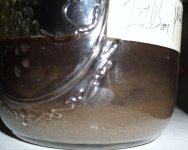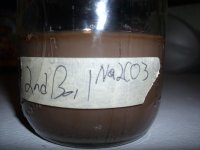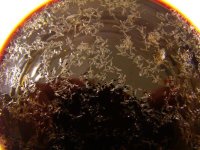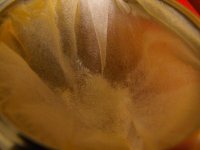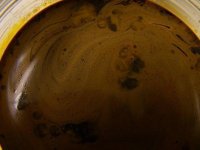logos2012 said:
Yeah he was thinking this but he figured that since it was freebased that it would be released from the plant matter and travel with the water, yet he sees the problem if one were to filter, it would probably get stuck in the filter right? Perhaps filtering while hot might help it migrate to the water?
I really dont think it would work, freebase dmt
might slightly dissolve in hot water, but i doubt all or most of it (though if you wanna try anyways, just dont throw anything away and have some solvent in case you need it)
logos2012 said:
He would rather use IPA than lye...So in that case, could one not just do IPA pulls on the drytek sodium carb mixture, then evaporate, then add to sodium carb water to crystallize?
check the cake extraction from spiceman, it works on this idea of making a freebased mimosa dry cake, pulling with some kind of alcohol and then evapping. But it will be very impure, and adding to sodium carb water wont make it crystallize because it will be already in freebase form. Maybe if you redissolve it in FASW and then add sodium carb saturated solution it could work. But this also brings me to:
logos2012 said:
This is just their opinion but the entities are of the understanding that the final result retains the energies of whatever chems were used in the process of making it. Even if it is fully washed and chemical analysis shows no traces, it still had to go through the process of being in that harsh environment to achieve the final result.
Ok I understand each one is free to have their opinion but:
Why is lye "harsh" ? Its just sodium and hydroxide ions. A lot of the common food you will eat can have come in contact with that too
Also what makes IPA any less harsh? It isnt a 'natural' solvent either, it involved a chemical synthesis to make it, which can have used chemicals such as sulfuric acid and also propene which comes from fossil fuels usually...
Maybe its rather your subjective ideas about it that is affecting the experience and not something objective about the chemical?
logos2012 said:
He doesn't like to have to wear goggles, gloves, solvent mask to protect face, etc.. if he doesn't have to.
I understand if you preffer a process where these risks are not there but, its just safety precautions, just like you wear seatbelt when driving a car and stop on redlights, or why you use shoes when walking on the streets or why electric sockets arent exposed metals to the outside but rather to the inside, whatever else. It doesnt necessarily make the whole thing bad, each thing we do in life has risks and we will measure whatever we feel is necessary and consider the risks and adapt to it, right?
Please dont take this all as an offense, Im just questioning because I feel its important to put our beliefs to test and to use other's feedback to make our ideas as reasonable as possible, but you should do exactly what you feel is right for you. Personally im all for finding teks that use the safest chemicals and I dont extract with petrochems for a long time, but I definitely dont think that objectively it makes the dmt worse if you used lye or something like this, as long as you make sure to follow safety precautions and clean up so that there arent traces of the chems. Lye is commonly used in a lot of food things, its just about being the right quantity and so on. But thats also just my opinion on the whole thing

logos2012 said:
He is also concerned a bit about it being in the final product.
What about the warm water wash?

